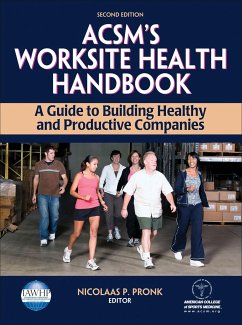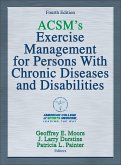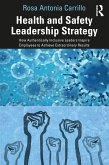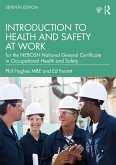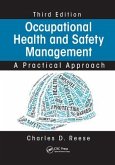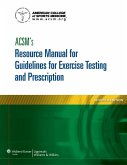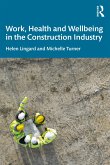American College of Sports Medicine
ACSM's Worksite Health Handbook
A Guide to Building Healthy and Productive Companies
American College of Sports Medicine
ACSM's Worksite Health Handbook
A Guide to Building Healthy and Productive Companies
- Gebundenes Buch
- Merkliste
- Auf die Merkliste
- Bewerten Bewerten
- Teilen
- Produkt teilen
- Produkterinnerung
- Produkterinnerung
ACSMâ s Worksite Health Handbook, Second Edition, has been thoroughly updated with the latest research and expanded to better support the business case for worksite programs. The text provides information on important contextual issues, evidence of effectiveness, assessment, program design, and strategies for encouraging employee involvement.
Andere Kunden interessierten sich auch für
![ACSM's Exercise Management for Persons With Chronic Diseases and Disabilities ACSM's Exercise Management for Persons With Chronic Diseases and Disabilities]() American College of Sports MedicineACSM's Exercise Management for Persons With Chronic Diseases and Disabilities106,99 €
American College of Sports MedicineACSM's Exercise Management for Persons With Chronic Diseases and Disabilities106,99 €![Health and Safety Leadership Strategy Health and Safety Leadership Strategy]() Rosa CarrilloHealth and Safety Leadership Strategy33,99 €
Rosa CarrilloHealth and Safety Leadership Strategy33,99 €![Introduction to Health and Safety at Work Introduction to Health and Safety at Work]() Phil Hughes MBEIntroduction to Health and Safety at Work81,99 €
Phil Hughes MBEIntroduction to Health and Safety at Work81,99 €![Occupational Health and Safety Management Occupational Health and Safety Management]() Charles D. ReeseOccupational Health and Safety Management58,99 €
Charles D. ReeseOccupational Health and Safety Management58,99 €![ACSM's Behavioral Aspects of Physical Activity and Exercise ACSM's Behavioral Aspects of Physical Activity and Exercise]() American College of Sports MedicineACSM's Behavioral Aspects of Physical Activity and Exercise86,99 €
American College of Sports MedicineACSM's Behavioral Aspects of Physical Activity and Exercise86,99 €![ACSM's Resource Manual for Guidelines for Exercise Testing and Prescription ACSM's Resource Manual for Guidelines for Exercise Testing and Prescription]() American College of Sports MedicineACSM's Resource Manual for Guidelines for Exercise Testing and Prescription91,99 €
American College of Sports MedicineACSM's Resource Manual for Guidelines for Exercise Testing and Prescription91,99 €![Work, Health and Wellbeing in the Construction Industry Work, Health and Wellbeing in the Construction Industry]() Helen LingardWork, Health and Wellbeing in the Construction Industry57,99 €
Helen LingardWork, Health and Wellbeing in the Construction Industry57,99 €-
-
ACSMâ s Worksite Health Handbook, Second Edition, has been thoroughly updated with the latest research and expanded to better support the business case for worksite programs. The text provides information on important contextual issues, evidence of effectiveness, assessment, program design, and strategies for encouraging employee involvement.
Produktdetails
- Produktdetails
- Verlag: Human Kinetics Publishers
- 2 ed
- Seitenzahl: 400
- Erscheinungstermin: 27. Februar 2009
- Englisch
- Abmessung: 289mm x 223mm x 30mm
- Gewicht: 1358g
- ISBN-13: 9780736074346
- ISBN-10: 0736074341
- Artikelnr.: 25434963
- Verlag: Human Kinetics Publishers
- 2 ed
- Seitenzahl: 400
- Erscheinungstermin: 27. Februar 2009
- Englisch
- Abmessung: 289mm x 223mm x 30mm
- Gewicht: 1358g
- ISBN-13: 9780736074346
- ISBN-10: 0736074341
- Artikelnr.: 25434963
Nicolaas P. Pronk, PhD, is the vice president of health management at HealthPartners in Bloomington, Minnesota, the largest consumer-governed, nonprofit health care organization in the nation. He is also senior research investigator at HealthPartners Research Foundation and health science officer of JourneyWell, a Minneapolis-based nationwide provider of health and wellness programs. Pronk has 20 years of experience in the health promotion field as a researcher, developer, and administrator of health promotion programs and services. Since 1993 he has directed health improvement initiatives that involve a systems approach to generating health across multiple sectors, including business and industry. He is a member of the distinguished Task Force on Community Preventive Services, an independent panel supported by the Centers for Disease Control and Prevention, which presents evidence-based recommendations to the health field. A member of the American College of Sports Medicine (ACSM) since 1984, Pronk served as section editor and contributor for the first edition of ACSM's Worksite Health Promotion Manual. He currently serves as associate editor for the ACSM's Health & Fitness Journal. He served as the chair for the ACSM Interest Group on Worksite Health Promotion until 2008, when it morphed into the International Association for Worksite Health Promotion (IAWHP), an ACSM affiliate society. Pronk is a founding member and inaugural president of the international board of directors for the IAWHP. Previously, he was a board member of the former Association for Worksite Health Promotion (AWHP). Pronk and his wife, Stephanie, reside in Eagan, Minnesota. He enjoys spending time with his family and dogs, watching English Football Association soccer after a Saturday-morning run, and riding his Harley on country roads in the Minnesota northland. ACSM advances and integrates scientific research to provide educational and practical applications of exercise science and sports medicine. The American College of Sports Medicine, founded in 1954, is a professional membership society with more than 20,000 national, regional, and international members in more than 70 countries dedicated to improving health through science, education, and medicine. ACSM members work in a wide range of medical specialties, allied health professions, and scientific disciplines. Our members are committed to the diagnosis, treatment, and prevention of sport-related injuries and the advancement of the science of exercise. Our members' diversity and expertise make ACSM the largest, most respected sports medicine and exercise science organization in the world. From astronauts and athletes to people with chronic diseases or physical challenges, ACSM continues to look for and find better methods to allow people to live longer and more productive lives. ACSM is leading the way in exercise science and sports medicine. ACSM reaches professionals and the public through a variety of means: -ACSM publishes periodicals such as Medicine & Science in Sports & Exercise , Sports Medicine Bulletin, Exercise and Sport Sciences Reviews, ACSM's Health & Fitness Journal, Current Sports Medicine Reports, and the online consumer newsletter ACSM Fit Society Page. -The ACSM Web site, www.acsm.org, serves as a portal to research, information, and professional development resources. -Meetings present the latest scientific research and practical and clinical applications as well as fitness techniques and public health issues. -Through media outreach, ACSM experts provide accurate, evidence-based insight into sports medicine, exercise science, and health and fitness. -Books, pamphlets, and other publications present consumer advice, standards and guidelines for practitioners, and other definitive iinformation.
Part I: Setting the Context Chapter 1: Population Health Management at the Worksite Nicolaas P. Pronk
PhD
FACSM Chapter 2: Employee Health Promotion: A Historical Perspective R. William Whitmer
MBA Chapter 3: Workplace-Based Health and Wellness Services Raymond Fabius
MD
CPE
and Sharon Glave Frazee
PhD Chapter 4: State of the Worksite Health Promotion Industry: The 2004 National Worksite Health Promotion Survey Laura A. Linnan
ScD
CHES Chapter 5: Health Promotion Programming in Small
Medium
and Large Businesses Heather M. Bowen
MS
RD
LD; Todd D. Smith
MS
CSP
ARM; Mark G. Wilson
HSD; and David M. Dejoy
PhD Chapter 6: Employee Health Promotion: A Legal Perspective Alison Cline Earles
Esq
and Luann Heinen
MPP Chapter 7: Health Care Policy and Health Promotion John M. Clymer
AB; Garry Lindsay
MPH
CHES; Jennifer Childress
MS
CHES; and George J. Pfeiffer MSE Chapter 8: The Case for Change: From Segregated to Integrated Employee Health Management Ann Yaktine
PhD
and Mike Parkinson
MD
MPH Part II: The Evidence for Employer-Sponsored Health Programs Chapter 9: An Introduction to Evidence on Worksite Health Promotion Jonathan E. Fielding
MD
MPH
MBA
and David P. Hopkins
MD
MPH Chapter 10: The Assessment of Health Risks With Feedback: Results of a Systematic Review Robin E. Soler
PhD; Matt Griffith
MPH; David P. Hopkins
MD
MPH; and Kimberly Leeks
PhD
MPH Chapter 11: Practice and Research Connected: A Synergistic Process of Translation Through Knowledge Transfer Nicolaas P. Pronk
PhD
FACSM Chapter 12: Benchmarking and Best Practices in Worksite Health Promotion Jessica Grossmeier
MPH; Lavaughn Palma-Davis
MA; K. Andrew Crighton
MD
CPE; Margaret Sabin
MHSA; and David R. Anderson
PhD Chapter 13: Health and the Organization of Work David Gimeno
PhD
and Benjamin C. Amick III
PhD Chapter 14: Health and Productivity Management: An Overview Joseph A. Leutzinger
PhD Part III: Assessing Worker and Organizational Health Chapter 15: Practical Program Evaluation: Ensuring Findings Are Used for Program Improvement Thomas J. Chapel
MA
MBA
and Jason Lang
MPH
MS Chapter 16: The Assessment of Health and Risk: Tools
Specific Uses
and Implementation Processes Edward M. Framer
PhD
and Yosuke Chikamoto
PhD Chapter 17: Organizational Assessment for Health Thomas Golaszewski
EdD Chapter 18: Assessment Tools for Employee Productivity Nicolaas P. Pronk
PhD
FACSM Chapter 19: Calculating the Economic Return of Health and Productivity Management Programs Seth Serxner
PhD
MPH
and Daniel Gold
PhD Chapter 20: Using Claims Analysis to Support Intervention Planning
Design
and Measurement David H. Chenoweth
PhD
and Jeff A. Hochberg
MS Part IV: Program Design and Implementation Chapter 21: Organizing Intelligence to Achieve Increased Consumer Engagement
Behavior Change
and Health Improvement Stephanie Pronk
MEd Chapter 22: The Application of Behavior Change Theory in the Worksite Setting Karen Glanz
PhD
MPH Chapter 23: Keeping Healthy Workers Healthy: Creating a Culture of Health Shirley Musich
PhD; Howard Schubiner
MD; and Timothy Mcdonald
MSHA Chapter 24: Connecting the Program to Core Business Objectives Steven P. Noeldner
PhD Chapter 25: Addressing Diversity and Health Literacy at the Worksite Antronette K. (Toni) Yancey
MD
MPH; A. Janet Tomiyama
MA; and Nicole Keith
PhD Chapter 26: A Culture of Health: Creating and Sustaining Supportive Organizational Environments for Health Nicolaas P. Pronk
PhD
FACSM
and Calvin U. Allen
MBA
CHIE Chapter 27: Online Communities and Worksite Health Management Neal Sofian
MSPH
and Daniel Newton
PhD Chapter 28: Rewarding Change: Principles for Implementing Worksite Incentive Programs Jeffrey J. VanWormer
MS
and Nicolaas P. Pronk
PhD
FACSM Chapter 29: eHealth for Employee Health and Wellness: Optimizing Plan Design and Incentive Management David K. Ahern
PhD; Lauren Buckel; Edward W. Aberger
PhD; and Michael J. Follick
PhD Chapter 30: Effective Programs to Promote Worker Health Within Healthy and Safe Worksites Glorian Sorensen
PhD
MPH
and Lisa Quintiliani
PhD Chapter 31: Programs Designed to Improve Employee Health Through Changes in the Built Environment Mireille N.M. van Poppel
PhD
and Luuk H. Engbers
PhD Chapter 32: The Design
Implementation
and Evaluation of Medical Self-Care Programs Don R. Powell
PhD
and Jeanette Karwan
RD Chapter 33: Disease Management for Employed Populations Dennis Richling
MD Chapter 34: From the Basics to Comprehensive Programming Mary Kruse
ATC Part V: Case Studies Chapter 35: The Occupational Athlete: Injury Reduction and Productivity Enhancement in Reforestation Workers Delia Roberts
PhD
FACSM Chapter 36: Employee Health at BAE Systems: An Employer-Health Plan Partnership Approach N. Marcus Thygeson
MD; Jason Gallagher
MBA; Kathleen Cross
CANP; and Nicolaas P. Pronk
PhD
FACSM Chapter 37: Health Promotion
Participation
and Productivity: A Case Study at Unilever PLC Peter Mills
MD
and Jessica Colling
BSC
MSC Chapter 38: Introducing Environmental Interventions at the Dow Chemical Company to Reduce Overweight and Obesity Among Workers Ron Z. Goetzel
PhD; Jennie Bowen
MPH; Ronald J. Ozminkowski
PhD; Cheryl Kassed PhD
MSPH; Enid Chung Roemer
PhD; Maryam J. Tabrizi
MS
CHES; Meghan Short
BA; Shaohung Wang
PhD; Xiaofei Pei
PhD; Heather M. Bowen
MS
RD
LD; David M. Dejoy
PhD; Mark G. Wilson
HSD; Kristin M. Baker
MPH; Karen J. Tully
BS; John M. White
PhD; Gary M. Billotti
MS; and Catherine M. Baase
MD
PhD
FACSM Chapter 2: Employee Health Promotion: A Historical Perspective R. William Whitmer
MBA Chapter 3: Workplace-Based Health and Wellness Services Raymond Fabius
MD
CPE
and Sharon Glave Frazee
PhD Chapter 4: State of the Worksite Health Promotion Industry: The 2004 National Worksite Health Promotion Survey Laura A. Linnan
ScD
CHES Chapter 5: Health Promotion Programming in Small
Medium
and Large Businesses Heather M. Bowen
MS
RD
LD; Todd D. Smith
MS
CSP
ARM; Mark G. Wilson
HSD; and David M. Dejoy
PhD Chapter 6: Employee Health Promotion: A Legal Perspective Alison Cline Earles
Esq
and Luann Heinen
MPP Chapter 7: Health Care Policy and Health Promotion John M. Clymer
AB; Garry Lindsay
MPH
CHES; Jennifer Childress
MS
CHES; and George J. Pfeiffer MSE Chapter 8: The Case for Change: From Segregated to Integrated Employee Health Management Ann Yaktine
PhD
and Mike Parkinson
MD
MPH Part II: The Evidence for Employer-Sponsored Health Programs Chapter 9: An Introduction to Evidence on Worksite Health Promotion Jonathan E. Fielding
MD
MPH
MBA
and David P. Hopkins
MD
MPH Chapter 10: The Assessment of Health Risks With Feedback: Results of a Systematic Review Robin E. Soler
PhD; Matt Griffith
MPH; David P. Hopkins
MD
MPH; and Kimberly Leeks
PhD
MPH Chapter 11: Practice and Research Connected: A Synergistic Process of Translation Through Knowledge Transfer Nicolaas P. Pronk
PhD
FACSM Chapter 12: Benchmarking and Best Practices in Worksite Health Promotion Jessica Grossmeier
MPH; Lavaughn Palma-Davis
MA; K. Andrew Crighton
MD
CPE; Margaret Sabin
MHSA; and David R. Anderson
PhD Chapter 13: Health and the Organization of Work David Gimeno
PhD
and Benjamin C. Amick III
PhD Chapter 14: Health and Productivity Management: An Overview Joseph A. Leutzinger
PhD Part III: Assessing Worker and Organizational Health Chapter 15: Practical Program Evaluation: Ensuring Findings Are Used for Program Improvement Thomas J. Chapel
MA
MBA
and Jason Lang
MPH
MS Chapter 16: The Assessment of Health and Risk: Tools
Specific Uses
and Implementation Processes Edward M. Framer
PhD
and Yosuke Chikamoto
PhD Chapter 17: Organizational Assessment for Health Thomas Golaszewski
EdD Chapter 18: Assessment Tools for Employee Productivity Nicolaas P. Pronk
PhD
FACSM Chapter 19: Calculating the Economic Return of Health and Productivity Management Programs Seth Serxner
PhD
MPH
and Daniel Gold
PhD Chapter 20: Using Claims Analysis to Support Intervention Planning
Design
and Measurement David H. Chenoweth
PhD
and Jeff A. Hochberg
MS Part IV: Program Design and Implementation Chapter 21: Organizing Intelligence to Achieve Increased Consumer Engagement
Behavior Change
and Health Improvement Stephanie Pronk
MEd Chapter 22: The Application of Behavior Change Theory in the Worksite Setting Karen Glanz
PhD
MPH Chapter 23: Keeping Healthy Workers Healthy: Creating a Culture of Health Shirley Musich
PhD; Howard Schubiner
MD; and Timothy Mcdonald
MSHA Chapter 24: Connecting the Program to Core Business Objectives Steven P. Noeldner
PhD Chapter 25: Addressing Diversity and Health Literacy at the Worksite Antronette K. (Toni) Yancey
MD
MPH; A. Janet Tomiyama
MA; and Nicole Keith
PhD Chapter 26: A Culture of Health: Creating and Sustaining Supportive Organizational Environments for Health Nicolaas P. Pronk
PhD
FACSM
and Calvin U. Allen
MBA
CHIE Chapter 27: Online Communities and Worksite Health Management Neal Sofian
MSPH
and Daniel Newton
PhD Chapter 28: Rewarding Change: Principles for Implementing Worksite Incentive Programs Jeffrey J. VanWormer
MS
and Nicolaas P. Pronk
PhD
FACSM Chapter 29: eHealth for Employee Health and Wellness: Optimizing Plan Design and Incentive Management David K. Ahern
PhD; Lauren Buckel; Edward W. Aberger
PhD; and Michael J. Follick
PhD Chapter 30: Effective Programs to Promote Worker Health Within Healthy and Safe Worksites Glorian Sorensen
PhD
MPH
and Lisa Quintiliani
PhD Chapter 31: Programs Designed to Improve Employee Health Through Changes in the Built Environment Mireille N.M. van Poppel
PhD
and Luuk H. Engbers
PhD Chapter 32: The Design
Implementation
and Evaluation of Medical Self-Care Programs Don R. Powell
PhD
and Jeanette Karwan
RD Chapter 33: Disease Management for Employed Populations Dennis Richling
MD Chapter 34: From the Basics to Comprehensive Programming Mary Kruse
ATC Part V: Case Studies Chapter 35: The Occupational Athlete: Injury Reduction and Productivity Enhancement in Reforestation Workers Delia Roberts
PhD
FACSM Chapter 36: Employee Health at BAE Systems: An Employer-Health Plan Partnership Approach N. Marcus Thygeson
MD; Jason Gallagher
MBA; Kathleen Cross
CANP; and Nicolaas P. Pronk
PhD
FACSM Chapter 37: Health Promotion
Participation
and Productivity: A Case Study at Unilever PLC Peter Mills
MD
and Jessica Colling
BSC
MSC Chapter 38: Introducing Environmental Interventions at the Dow Chemical Company to Reduce Overweight and Obesity Among Workers Ron Z. Goetzel
PhD; Jennie Bowen
MPH; Ronald J. Ozminkowski
PhD; Cheryl Kassed PhD
MSPH; Enid Chung Roemer
PhD; Maryam J. Tabrizi
MS
CHES; Meghan Short
BA; Shaohung Wang
PhD; Xiaofei Pei
PhD; Heather M. Bowen
MS
RD
LD; David M. Dejoy
PhD; Mark G. Wilson
HSD; Kristin M. Baker
MPH; Karen J. Tully
BS; John M. White
PhD; Gary M. Billotti
MS; and Catherine M. Baase
MD
Part I: Setting the Context Chapter 1: Population Health Management at the Worksite Nicolaas P. Pronk
PhD
FACSM Chapter 2: Employee Health Promotion: A Historical Perspective R. William Whitmer
MBA Chapter 3: Workplace-Based Health and Wellness Services Raymond Fabius
MD
CPE
and Sharon Glave Frazee
PhD Chapter 4: State of the Worksite Health Promotion Industry: The 2004 National Worksite Health Promotion Survey Laura A. Linnan
ScD
CHES Chapter 5: Health Promotion Programming in Small
Medium
and Large Businesses Heather M. Bowen
MS
RD
LD; Todd D. Smith
MS
CSP
ARM; Mark G. Wilson
HSD; and David M. Dejoy
PhD Chapter 6: Employee Health Promotion: A Legal Perspective Alison Cline Earles
Esq
and Luann Heinen
MPP Chapter 7: Health Care Policy and Health Promotion John M. Clymer
AB; Garry Lindsay
MPH
CHES; Jennifer Childress
MS
CHES; and George J. Pfeiffer MSE Chapter 8: The Case for Change: From Segregated to Integrated Employee Health Management Ann Yaktine
PhD
and Mike Parkinson
MD
MPH Part II: The Evidence for Employer-Sponsored Health Programs Chapter 9: An Introduction to Evidence on Worksite Health Promotion Jonathan E. Fielding
MD
MPH
MBA
and David P. Hopkins
MD
MPH Chapter 10: The Assessment of Health Risks With Feedback: Results of a Systematic Review Robin E. Soler
PhD; Matt Griffith
MPH; David P. Hopkins
MD
MPH; and Kimberly Leeks
PhD
MPH Chapter 11: Practice and Research Connected: A Synergistic Process of Translation Through Knowledge Transfer Nicolaas P. Pronk
PhD
FACSM Chapter 12: Benchmarking and Best Practices in Worksite Health Promotion Jessica Grossmeier
MPH; Lavaughn Palma-Davis
MA; K. Andrew Crighton
MD
CPE; Margaret Sabin
MHSA; and David R. Anderson
PhD Chapter 13: Health and the Organization of Work David Gimeno
PhD
and Benjamin C. Amick III
PhD Chapter 14: Health and Productivity Management: An Overview Joseph A. Leutzinger
PhD Part III: Assessing Worker and Organizational Health Chapter 15: Practical Program Evaluation: Ensuring Findings Are Used for Program Improvement Thomas J. Chapel
MA
MBA
and Jason Lang
MPH
MS Chapter 16: The Assessment of Health and Risk: Tools
Specific Uses
and Implementation Processes Edward M. Framer
PhD
and Yosuke Chikamoto
PhD Chapter 17: Organizational Assessment for Health Thomas Golaszewski
EdD Chapter 18: Assessment Tools for Employee Productivity Nicolaas P. Pronk
PhD
FACSM Chapter 19: Calculating the Economic Return of Health and Productivity Management Programs Seth Serxner
PhD
MPH
and Daniel Gold
PhD Chapter 20: Using Claims Analysis to Support Intervention Planning
Design
and Measurement David H. Chenoweth
PhD
and Jeff A. Hochberg
MS Part IV: Program Design and Implementation Chapter 21: Organizing Intelligence to Achieve Increased Consumer Engagement
Behavior Change
and Health Improvement Stephanie Pronk
MEd Chapter 22: The Application of Behavior Change Theory in the Worksite Setting Karen Glanz
PhD
MPH Chapter 23: Keeping Healthy Workers Healthy: Creating a Culture of Health Shirley Musich
PhD; Howard Schubiner
MD; and Timothy Mcdonald
MSHA Chapter 24: Connecting the Program to Core Business Objectives Steven P. Noeldner
PhD Chapter 25: Addressing Diversity and Health Literacy at the Worksite Antronette K. (Toni) Yancey
MD
MPH; A. Janet Tomiyama
MA; and Nicole Keith
PhD Chapter 26: A Culture of Health: Creating and Sustaining Supportive Organizational Environments for Health Nicolaas P. Pronk
PhD
FACSM
and Calvin U. Allen
MBA
CHIE Chapter 27: Online Communities and Worksite Health Management Neal Sofian
MSPH
and Daniel Newton
PhD Chapter 28: Rewarding Change: Principles for Implementing Worksite Incentive Programs Jeffrey J. VanWormer
MS
and Nicolaas P. Pronk
PhD
FACSM Chapter 29: eHealth for Employee Health and Wellness: Optimizing Plan Design and Incentive Management David K. Ahern
PhD; Lauren Buckel; Edward W. Aberger
PhD; and Michael J. Follick
PhD Chapter 30: Effective Programs to Promote Worker Health Within Healthy and Safe Worksites Glorian Sorensen
PhD
MPH
and Lisa Quintiliani
PhD Chapter 31: Programs Designed to Improve Employee Health Through Changes in the Built Environment Mireille N.M. van Poppel
PhD
and Luuk H. Engbers
PhD Chapter 32: The Design
Implementation
and Evaluation of Medical Self-Care Programs Don R. Powell
PhD
and Jeanette Karwan
RD Chapter 33: Disease Management for Employed Populations Dennis Richling
MD Chapter 34: From the Basics to Comprehensive Programming Mary Kruse
ATC Part V: Case Studies Chapter 35: The Occupational Athlete: Injury Reduction and Productivity Enhancement in Reforestation Workers Delia Roberts
PhD
FACSM Chapter 36: Employee Health at BAE Systems: An Employer-Health Plan Partnership Approach N. Marcus Thygeson
MD; Jason Gallagher
MBA; Kathleen Cross
CANP; and Nicolaas P. Pronk
PhD
FACSM Chapter 37: Health Promotion
Participation
and Productivity: A Case Study at Unilever PLC Peter Mills
MD
and Jessica Colling
BSC
MSC Chapter 38: Introducing Environmental Interventions at the Dow Chemical Company to Reduce Overweight and Obesity Among Workers Ron Z. Goetzel
PhD; Jennie Bowen
MPH; Ronald J. Ozminkowski
PhD; Cheryl Kassed PhD
MSPH; Enid Chung Roemer
PhD; Maryam J. Tabrizi
MS
CHES; Meghan Short
BA; Shaohung Wang
PhD; Xiaofei Pei
PhD; Heather M. Bowen
MS
RD
LD; David M. Dejoy
PhD; Mark G. Wilson
HSD; Kristin M. Baker
MPH; Karen J. Tully
BS; John M. White
PhD; Gary M. Billotti
MS; and Catherine M. Baase
MD
PhD
FACSM Chapter 2: Employee Health Promotion: A Historical Perspective R. William Whitmer
MBA Chapter 3: Workplace-Based Health and Wellness Services Raymond Fabius
MD
CPE
and Sharon Glave Frazee
PhD Chapter 4: State of the Worksite Health Promotion Industry: The 2004 National Worksite Health Promotion Survey Laura A. Linnan
ScD
CHES Chapter 5: Health Promotion Programming in Small
Medium
and Large Businesses Heather M. Bowen
MS
RD
LD; Todd D. Smith
MS
CSP
ARM; Mark G. Wilson
HSD; and David M. Dejoy
PhD Chapter 6: Employee Health Promotion: A Legal Perspective Alison Cline Earles
Esq
and Luann Heinen
MPP Chapter 7: Health Care Policy and Health Promotion John M. Clymer
AB; Garry Lindsay
MPH
CHES; Jennifer Childress
MS
CHES; and George J. Pfeiffer MSE Chapter 8: The Case for Change: From Segregated to Integrated Employee Health Management Ann Yaktine
PhD
and Mike Parkinson
MD
MPH Part II: The Evidence for Employer-Sponsored Health Programs Chapter 9: An Introduction to Evidence on Worksite Health Promotion Jonathan E. Fielding
MD
MPH
MBA
and David P. Hopkins
MD
MPH Chapter 10: The Assessment of Health Risks With Feedback: Results of a Systematic Review Robin E. Soler
PhD; Matt Griffith
MPH; David P. Hopkins
MD
MPH; and Kimberly Leeks
PhD
MPH Chapter 11: Practice and Research Connected: A Synergistic Process of Translation Through Knowledge Transfer Nicolaas P. Pronk
PhD
FACSM Chapter 12: Benchmarking and Best Practices in Worksite Health Promotion Jessica Grossmeier
MPH; Lavaughn Palma-Davis
MA; K. Andrew Crighton
MD
CPE; Margaret Sabin
MHSA; and David R. Anderson
PhD Chapter 13: Health and the Organization of Work David Gimeno
PhD
and Benjamin C. Amick III
PhD Chapter 14: Health and Productivity Management: An Overview Joseph A. Leutzinger
PhD Part III: Assessing Worker and Organizational Health Chapter 15: Practical Program Evaluation: Ensuring Findings Are Used for Program Improvement Thomas J. Chapel
MA
MBA
and Jason Lang
MPH
MS Chapter 16: The Assessment of Health and Risk: Tools
Specific Uses
and Implementation Processes Edward M. Framer
PhD
and Yosuke Chikamoto
PhD Chapter 17: Organizational Assessment for Health Thomas Golaszewski
EdD Chapter 18: Assessment Tools for Employee Productivity Nicolaas P. Pronk
PhD
FACSM Chapter 19: Calculating the Economic Return of Health and Productivity Management Programs Seth Serxner
PhD
MPH
and Daniel Gold
PhD Chapter 20: Using Claims Analysis to Support Intervention Planning
Design
and Measurement David H. Chenoweth
PhD
and Jeff A. Hochberg
MS Part IV: Program Design and Implementation Chapter 21: Organizing Intelligence to Achieve Increased Consumer Engagement
Behavior Change
and Health Improvement Stephanie Pronk
MEd Chapter 22: The Application of Behavior Change Theory in the Worksite Setting Karen Glanz
PhD
MPH Chapter 23: Keeping Healthy Workers Healthy: Creating a Culture of Health Shirley Musich
PhD; Howard Schubiner
MD; and Timothy Mcdonald
MSHA Chapter 24: Connecting the Program to Core Business Objectives Steven P. Noeldner
PhD Chapter 25: Addressing Diversity and Health Literacy at the Worksite Antronette K. (Toni) Yancey
MD
MPH; A. Janet Tomiyama
MA; and Nicole Keith
PhD Chapter 26: A Culture of Health: Creating and Sustaining Supportive Organizational Environments for Health Nicolaas P. Pronk
PhD
FACSM
and Calvin U. Allen
MBA
CHIE Chapter 27: Online Communities and Worksite Health Management Neal Sofian
MSPH
and Daniel Newton
PhD Chapter 28: Rewarding Change: Principles for Implementing Worksite Incentive Programs Jeffrey J. VanWormer
MS
and Nicolaas P. Pronk
PhD
FACSM Chapter 29: eHealth for Employee Health and Wellness: Optimizing Plan Design and Incentive Management David K. Ahern
PhD; Lauren Buckel; Edward W. Aberger
PhD; and Michael J. Follick
PhD Chapter 30: Effective Programs to Promote Worker Health Within Healthy and Safe Worksites Glorian Sorensen
PhD
MPH
and Lisa Quintiliani
PhD Chapter 31: Programs Designed to Improve Employee Health Through Changes in the Built Environment Mireille N.M. van Poppel
PhD
and Luuk H. Engbers
PhD Chapter 32: The Design
Implementation
and Evaluation of Medical Self-Care Programs Don R. Powell
PhD
and Jeanette Karwan
RD Chapter 33: Disease Management for Employed Populations Dennis Richling
MD Chapter 34: From the Basics to Comprehensive Programming Mary Kruse
ATC Part V: Case Studies Chapter 35: The Occupational Athlete: Injury Reduction and Productivity Enhancement in Reforestation Workers Delia Roberts
PhD
FACSM Chapter 36: Employee Health at BAE Systems: An Employer-Health Plan Partnership Approach N. Marcus Thygeson
MD; Jason Gallagher
MBA; Kathleen Cross
CANP; and Nicolaas P. Pronk
PhD
FACSM Chapter 37: Health Promotion
Participation
and Productivity: A Case Study at Unilever PLC Peter Mills
MD
and Jessica Colling
BSC
MSC Chapter 38: Introducing Environmental Interventions at the Dow Chemical Company to Reduce Overweight and Obesity Among Workers Ron Z. Goetzel
PhD; Jennie Bowen
MPH; Ronald J. Ozminkowski
PhD; Cheryl Kassed PhD
MSPH; Enid Chung Roemer
PhD; Maryam J. Tabrizi
MS
CHES; Meghan Short
BA; Shaohung Wang
PhD; Xiaofei Pei
PhD; Heather M. Bowen
MS
RD
LD; David M. Dejoy
PhD; Mark G. Wilson
HSD; Kristin M. Baker
MPH; Karen J. Tully
BS; John M. White
PhD; Gary M. Billotti
MS; and Catherine M. Baase
MD
